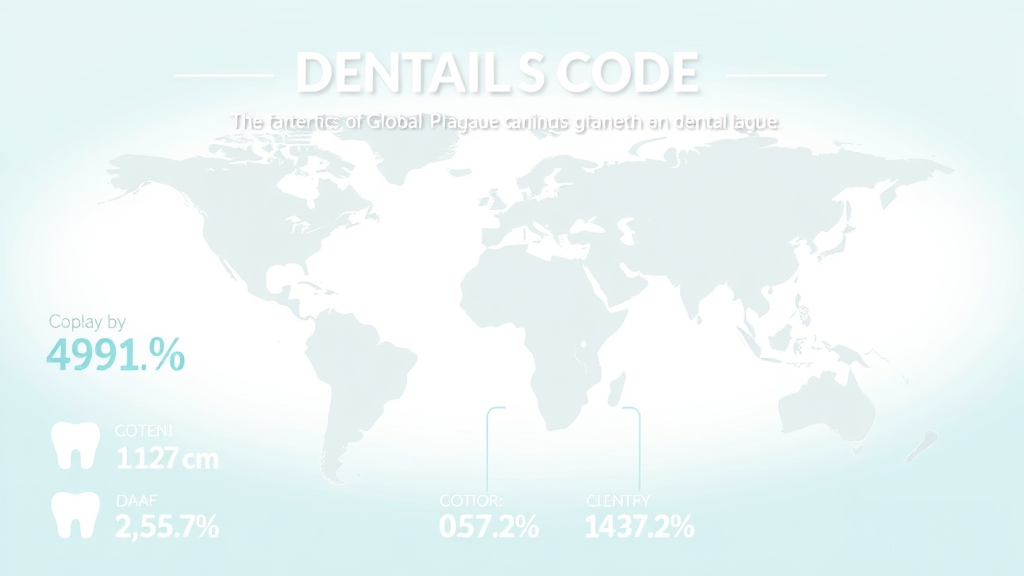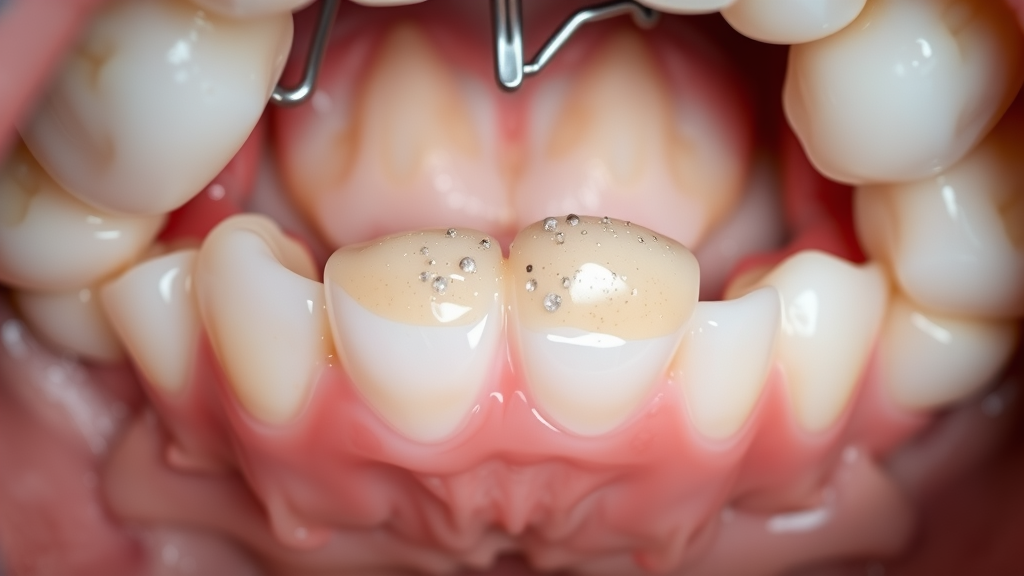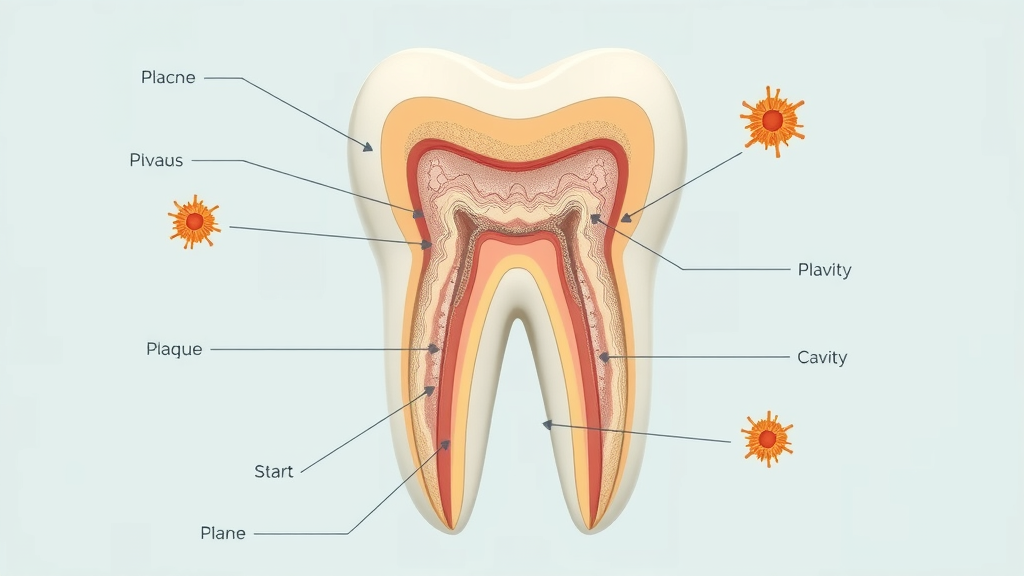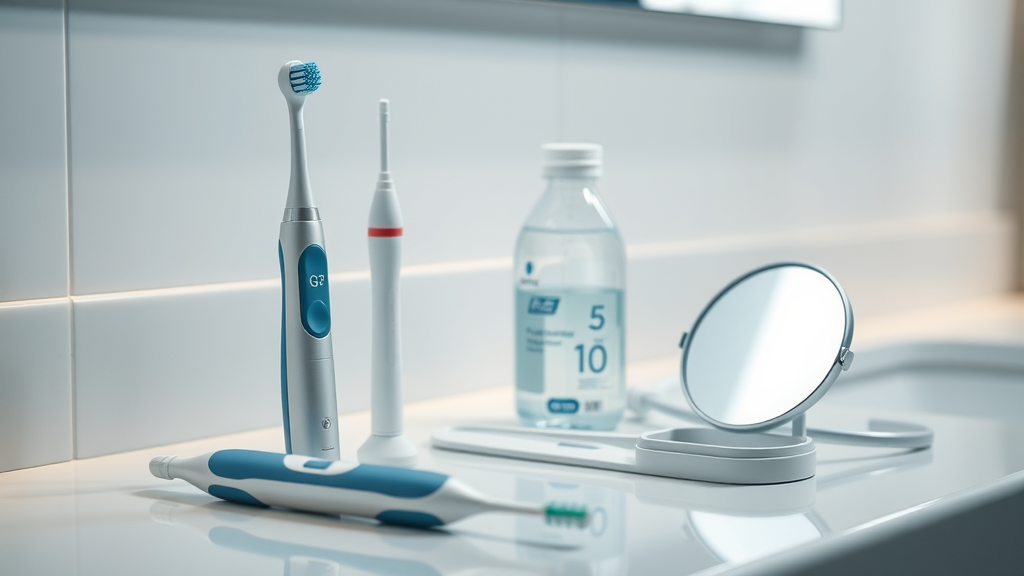Did you know nearly 7 out of 10 adults worldwide struggle with dental plaque? This seemingly invisible film is the silent enemy of good oral health, but many don’t realize how quickly it can cause serious problems. Uncover the hidden dangers of plaque, discover why it forms so fast, and learn what steps you can take today to protect your teeth and overall health. Keep reading for expert insights, simple prevention tips, and the surprising connections between the health of your mouth and your whole body.
Understanding What is Plaque, and Why is it Harmful: The Foundation of Good Oral Care
The question what is plaque, and why is it harmful rests at the core of good oral health. Plaque is far more than just a nuisance—it's a sticky film of bacteria that continuously forms on your teeth and gums. Most people don't notice plaque accumulating, but left untreated, it can pave the way for gum disease, cavities, and even impact your general well-being.
Learning about dental plaque helps you appreciate why preventive routines matter so much. Without regular dental cleanings and proper oral hygiene at home, this film hardens into tartar, making it even tougher to remove. Knowing the facts about plaque buildup empowers you to make small daily choices—like brushing and flossing —with big long-term health impacts.
What makes plaque especially harmful is its ability to trap food particles , shelter bacteria, and trigger a chain reaction that damages both your tooth enamel and your gums. Every time you eat, the bacteria in your mouth feed on sugars and release acids. Over time, these acids eat away at your teeth and irritate your gum line, which is why experts emphasize good oral hygiene every single day.
A Startling Statistic: Dental Plaque Affects 68% of Adults Worldwide

According to the World Health Organization, around 68% of adults globally are affected by some form of dental plaque. This highlights just how common—and often underestimated—this issue is. Plaque doesn't discriminate; it affects people of all ages, backgrounds, and health conditions. Even children can be affected if good oral hygiene habits aren’t developed early on.
Because dental plaque is so prevalent, it’s one of the leading causes behind rising rates of gum disease and tooth decay worldwide. This startling figure serves as a wake-up call: everyone, regardless of age or location, is at risk. Yet, with the right knowledge and regular preventive actions, it’s entirely possible to keep plaque in check and safeguard your oral health for life.
Breaking Down Plaque: Definition and Composition
Plaque is best described as a colorless or pale yellow, sticky film made up primarily of bacteria, mucus, and remnants of food particles. It forms quickly after eating and can be detected by running your tongue along your teeth; if you feel a fuzzy or “coated” sensation, you’re likely feeling plaque.
The main component of dental plaque is bacteria—specifically, hundreds of species that live naturally in the human mouth. While some bacteria are harmless or even beneficial, others can be harmful, especially when left to accumulate. Plaque also contains substances from your saliva which help the bacteria adhere to your teeth, making the film difficult to remove without proper oral hygiene practices.
The longer plaque remains on your teeth and gums, the more dangerous it becomes. Over time, minerals from saliva can harden the plaque into tartar, or dental calculus—creating an even more stubborn layer that only a dental professional can remove safely. This cycle can put both your teeth and gums at risk, emphasizing the importance of disrupting plaque formation regularly.
How Plaque Forms and Why Plaque Buildup Matters for Oral Health
Understanding plaque formation is essential to knowing how to prevent it and why it’s so problematic. Plaque starts to form minutes after you finish eating, especially if your diet includes sugars or starches. The bacteria in your mouth transform these food particles into acids, which then mix with your saliva to create a film that sticks to the tooth’s surface, particularly along the gum line .
If not removed effectively with brushing and flossing, this sticky film grows thicker and can cover more areas of your teeth and gums. Eventually, calcium and other minerals in your saliva begin to calcify the plaque, turning it into an even harder substance known as tartar. At this stage, only a professional dental cleaning can successfully clear away this hardened plaque buildup.
Plaque’s rapid formation and resilient nature makes it the underlying cause of virtually all dental problems. Apart from causing cavities and tooth decay , plaque is also a direct contributor to gum disease and often leads to bad breath . That’s why disrupting plaque every day with effective oral hygiene is the most important habit for maintaining long-term oral health.
For those looking to take their oral hygiene a step further, understanding the philosophy behind expert dental care can provide valuable context for daily routines and preventive strategies. You can explore how a patient-centered approach supports long-term oral health by visiting the Johnstown Dental Care philosophy of expert dentistry .
The Science: How Does Dental Plaque Form?

Dental plaque forms on your teeth as soon as bacteria encounter food particles. After eating, the bacteria in your mouth feed on residual sugars and starches, turning them into acid byproducts. These byproducts combine with proteins and other elements in your saliva, causing a gel-like film to begin coating your teeth and gums almost immediately.
This process happens rapidly: studies show that dental plaque can start forming within 20 minutes of eating. If not removed during brushing and flossing, the biofilm grows and multiplies, covering more of the tooth surface and seeping below the gum line . Additionally, the longer plaque remains undisturbed, the more organized and resilient the bacterial colonies become, making them harder to remove.
With each meal or snack, this process is repeated, reinforcing the need for consistent oral hygiene practices. It’s also why good oral health relies on interrupting the plaque formation process before it can cause lasting damage to your mouth and body.
What Promotes Plaque Buildup and Rapid Accumulation?
Several factors contribute to faster plaque buildup . Diet plays a huge role—frequent snacking on sugary, sticky, or highly processed foods fuels the bacteria responsible for plaque formation. Additionally, drinks that are sweet or acidic (like soda) increase acid production in the mouth, accelerating the development of dental plaque.
Poor or inconsistent oral hygiene is another major factor. When brushing and flossing are skipped or done incorrectly, leftover food particles and bacteria are left undisturbed, permitting thick layers of sticky film to accumulate. If you don’t visit your dental professional for regular dental cleanings, hardened tartar can form, trapping even more bacteria and causing stubborn plaque and tartar buildup.
Other contributing factors include dry mouth (often a side effect of certain medications or dehydration), crowded or misaligned teeth that are hard to clean, smoking or tobacco use, and even underlying medical conditions like diabetes. Recognizing these risk factors allows you to take steps toward protecting your oral health before problems arise.
From Plaque to Tartar: Escalating Concerns in Oral Hygiene
When plaque is not removed properly, it hardens and becomes tartar or calculus—a rough, porous deposit that sticks stubbornly to the teeth, especially near the gum line . This transition from soft, sticky plaque to rock-hard tartar is not just a cosmetic issue. Tartar creates an even rougher surface for more plaque to cling to, compounding the problem.
Plaque and tartar buildup are prime culprits behind ongoing inflammation of the gums, which eventually leads to more severe health concerns like gum disease and tooth loss. Unlike plaque, which can be removed with daily brushing and flossing , tartar needs to be scraped off by a dental professional during a dental cleaning.
Allowing tartar to build up unaddressed can not only damage your teeth and gums but also increase your risk of health problems beyond your mouth. It serves as a stark reminder of why regular dental visits and daily hygiene routines are so important in keeping your mouth—and your body—healthy.
Why Plaque is Harmful: Dangers to Oral Health and Beyond
The real danger of plaque extends far beyond just dirty teeth; it threatens both your immediate and long-term oral health . When plaque accumulates, it causes ongoing irritation and inflammation, especially in the delicate tissues around your teeth. This chronic inflammation is the underlying driver behind many serious dental and general health concerns.
Left unchecked, plaque is directly responsible for a cascade of oral health problems, including gum disease , tooth decay, chronic bad breath, and even bone loss in the jaw. Additionally, growing research shows the bacteria in plaque can travel through the bloodstream, potentially raising your risk for conditions like heart disease and diabetes.
Understanding the full scope of risks—both inside and outside the mouth—makes it clear why daily plaque removal and regular dental cleanings should be top priorities in your health routine.
How Dental Plaque Leads to Gum Disease
One of the most immediate dangers of plaque is its role in gum disease . Plaque irritates and inflames the soft tissue of the gums, leading to a condition called gingivitis . Early signs include redness, swelling, and bleeding along the gum line, especially when brushing or flossing.
If gingivitis is allowed to progress, the condition can become periodontitis , where the gum tissue pulls away from the teeth and pockets of infection develop. These deep infections can eventually destroy the bone that supports your teeth, risking tooth loss and even affecting facial structure.
Regular dental cleanings and excellent oral hygiene can prevent or reverse early gum disease, making them essential for preserving gum health and preventing potentially irreversible damage.
Plaque and Its Connection to Tooth Decay and Cavities

Plaque is the number one cause of tooth decay and cavities. As bacteria in plaque break down the sugars from your food, they produce acids that slowly erode tooth enamel . Over time, this weakens and dissolves the protective surface of the tooth, creating a cavity or hole.
If left undetected or untreated, cavities can progress deep into the tooth, causing pain, infection, and eventually total tooth loss. Worse, damaged teeth may require costly treatments like fillings, crowns, or even root canals. Prevention, through daily brushing and flossing , is always preferable and far more affordable than advanced dental intervention.
The takeaway? Properly addressing plaque buildup can save your teeth from unnecessary discomfort and expensive procedures—while keeping your smile healthy and your breath fresh.
Exploring the Broader Health Risks of Plaque

Researchers have discovered a strong link between poor oral hygiene and a host of systemic health problems. The harmful bacteria and chronic inflammation caused by dental plaque don’t just affect your mouth—they can affect your heart, brain, and overall immune system. These bacteria may enter the bloodstream through diseased gums, increasing the risk of serious conditions such as heart disease , stroke, diabetes complications, and even respiratory infections.
Chronic inflammation—sparked by ignored or untreated plaque—has been shown to worsen the effects of diseases like diabetes and may play a role in the development of certain types of cancer. Additionally, pregnant women with severe gum disease have a higher risk of preterm birth and low birth weight babies.
This expanding body of evidence shows why good oral hygiene isn’t just about maintaining a bright smile, but protecting your health from head to toe.
Recognizing Plaque: Signs, Symptoms, and When to Seek a Dental Professional
Plaque is often invisible to the naked eye, but it leaves subtle clues. Early detection is key to keeping your mouth healthy, so understanding the signs and symptoms of plaque buildup is important for people of all ages.
By staying tuned to changes in your mouth and being proactive about oral hygiene, you can reduce your risk of more serious problems. Paying attention to the state of your teeth and gums, and visiting your dental professional regularly, keeps plaque from progressing and causing lasting harm.
Below are common symptoms associated with plaque, along with guidance on when it’s time to seek professional dental help.
Common Symptoms of Plaque Buildup

Typical signals that you have excess plaque include a frequent “fuzzy” sensation on your teeth, especially after meals, as well as visibly yellow or off-white deposits near the gum line . You might also experience chronically bad breath , a persistent bad taste in your mouth, swollen or bleeding gums, and—sometimes—tenderness or mild discomfort.
As plaque builds up, these symptoms can intensify. Eventually, gum irritation, visible inflammation, and even minor bleeding from everyday brushing or flossing may occur. Neglecting to address these warning signs puts your oral health further at risk.
Don’t ignore the signs! If you consistently notice these symptoms despite your best efforts at brushing and flossing , it may be time for a professional evaluation and dental cleaning.
When to Visit a Dental Professional for Plaque Concerns
If symptoms like bleeding gums , persistent bad breath, sensitivity, or obvious plaque deposits don’t resolve after a few days of good oral hygiene, it’s time to consult your dental professional . Waiting too long can allow minor irritation to turn into full-blown gum disease or cavities that require much more intensive treatment.
Ideally, you should schedule regular dental checkups every six months for a thorough cleaning and evaluation. If you wear braces or have other dental appliances, you may need even more frequent cleanings to manage plaque and tartar. Remember, only your dentist or hygienist can remove plaque that has hardened into tartar.
Taking preventive action and seeking professional help at the first sign of trouble safeguards your teeth, gums, and your overall well-being. Don’t hesitate to reach out for expert care—especially if you suspect plaque buildup is getting out of control.
Best Ways to Prevent Plaque and Maintain Oral Hygiene
Preventing plaque buildup takes daily diligence and attention to detail, but the habits are simple and well worth the effort. Your first line of defense includes brushing your teeth at least twice per day, using a fluoride toothpaste and proper technique. Daily flossing is also crucial, as it clears debris from spots your brush can’t reach—especially between teeth and just below the gum line .
Establishing a solid home routine is only part of the equation. For best results, pair at-home care with regular professional cleanings. Many dental problems start silently, so only your dental professional can spot issues early and remove tartar before it leads to more serious health problems.
By combining a personal commitment to good oral hygiene with expert guidance, you can dramatically reduce your risk of gum disease, cavities, and other complications for life.
Tips for Good Oral Hygiene at Home

Developing a strong oral hygiene routine at home sets the foundation for a lifetime of healthy smiles. Here’s how to make the most of your daily care:
-
Brush your teeth for two full minutes, twice a day, using a soft-bristled brush and fluoride toothpaste.
-
Floss once daily, making sure to get between every tooth and just under the gum line.
-
Rinse with an antimicrobial mouthwash to help control bacteria and freshen breath.
-
Replace your toothbrush every 3-4 months, or sooner if the bristles are frayed.
You can also reduce plaque formation by minimizing sugary and starchy snacks, drinking plenty of water, and brushing after meals whenever possible. For those with braces, bridges, or other dental appliances, a water flosser or specialized cleaning tools can make it easier to keep plaque at bay.
Making these habits part of your family routine helps everyone—kids and adults alike—achieve and maintain good oral health .
The Importance of Professional Cleanings in Preventing Plaque and Tartar
Even the most diligent home care can miss hard-to-reach spots, which is why regular dental cleanings are vital. A dental professional has specialized tools to remove tartar and deep plaque, especially below the gum line, that you simply can’t eliminate on your own.
Professional cleanings not only make your teeth feel cleaner—they also provide a crucial opportunity for your dentist or hygienist to check for early signs of gum disease, tooth decay , and other illnesses. Often, problems caught in their early stages can be reversed or treated with minimal discomfort or cost.
Consider the advice of Dr. Emily Ross, DDS:
"The fight against plaque is won daily, not yearly—prevention is the cornerstone of a healthy smile."
Effective Strategies for Removing Plaque and Improving Oral Health
There’s no magic bullet—lasting protection against plaque comes from a consistent, multi-step approach. Here’s a tried-and-true daily dental plaque removal routine that really works:
-
Brushing teeth twice daily with fluoride toothpaste
-
Flossing or using interdental brushes
-
Rinsing with antimicrobial mouthwash
-
Using dental tools safely at home
These actions, reinforced by regular professional cleanings, can prevent most plaque-related issues.
If you’re interested in optimizing your results, consider upgrading your equipment. Modern electric toothbrushes, water flossers, and specialized picks can improve your effectiveness and make daily oral care easier.
Products and Tools to Support Good Oral Hygiene

Choosing the right tools makes a significant difference in how effectively you can remove plaque . The essentials include a soft-bristled toothbrush (manual or electric), quality dental floss, and an antimicrobial or fluoride mouthwash. Electric toothbrushes and water flossers have been shown in studies to reduce plaque buildup more thoroughly than traditional options.
Other valuable tools include interdental brushes (great for cleaning around braces or bridges) and a dental mirror for self-examination at home. Many dentists recommend a tongue scraper to reduce bacteria that contribute to bad breath .
Remember: no tool replaces consistent use. Select products that fit comfortably into your routine and that you’ll use every day—your oral health will thank you for it.
Comparison Table: Methods and Effectiveness for Removing Dental Plaque
|
Method |
Effectiveness |
Recommended Frequency |
|---|---|---|
|
Toothbrushing |
High |
Twice daily |
|
Flossing |
Moderate |
Daily |
|
Professional Cleaning |
Very High |
Every 6 months |
|
Mouthwash |
Moderate |
Daily |
People Also Ask: Addressing Common Concerns About What is Plaque, and Why is it Harmful
Why is plaque harmful?
Plaque is harmful because it causes inflammation in the gums, leads to gum disease, increases the risk of cavities , and can result in tooth loss if untreated. The bacteria in plaque produce acids and toxins that damage both the teeth and the gum tissue. Over time, these irritants can also find their way into your bloodstream, contributing to broader health complications.
Why does plaque build up so quickly?
Plaque begins forming within hours of eating as bacteria feed on sugars and starches, producing acids that adhere to tooth surfaces. These acids and sticky byproducts create an environment where new bacteria can thrive, leading to rapid buildup—especially if oral hygiene practices are inconsistent. Skipping regular brushing and flossing gives the film of bacteria time to organize and reinforce itself.
Can you get rid of plaque?
Yes, you can remove plaque with daily brushing, flossing, and the use of antimicrobial mouthwashes. However, once the soft film hardens into tartar, only a dental professional can remove it safely. Keeping up with regular dental cleanings ensures that any stubborn deposits are cleared before they lead to more serious problems.
What are the dangers of plaque?
Plaque can lead to gum disease, tooth loss, infections, and chronic bad breath . When left untreated, it has also been linked to systemic health problems such as heart disease and diabetes. By neglecting plaque removal, you not only threaten your mouth but your entire well-being.
Expert Answers: Frequently Asked Questions About What is Plaque, and Why is it Harmful
-
Is plaque the same as tartar? No. Plaque is a soft, sticky film of bacteria that forms on your teeth; tartar is plaque that has hardened and requires professional removal.
-
Can certain foods prevent plaque? Some foods, like crisp fruits and vegetables, can help remove food debris from teeth, but no food will prevent plaque entirely—consistent hygiene is essential.
-
Does mouthwash really help? Yes. Antimicrobial and fluoride mouthwashes help reduce bacteria and slow plaque buildup, but won’t replace brushing and flossing.
-
How quickly does plaque turn to tartar? In as little as 24 to 72 hours, unremoved plaque can begin to harden into tartar, particularly around the gum line.
-
Are children more at risk for plaque buildup? Children and teenagers are especially vulnerable due to diet and less consistent hygiene habits. Good oral hygiene learned early can prevent future issues.
-
Can plaque be reversed? Early plaque can be completely removed with proper cleaning; advanced tartar or gum disease may require professional treatment.
-
Does genetics affect plaque formation? Genetics can influence your mouth’s environment, making some people more susceptible, but daily care remains the largest factor in plaque prevention.
Key Actions for Better Oral Health: What You Need to Do to Prevent Harm from Plaque
-
Maintain a consistent oral hygiene routine
-
Use dentist-recommended dental products
-
Visit a dental professional every six months
-
Limit sugary and starchy snacks
-
Stay informed about oral health advances

"A healthy mouth is a gateway to a healthy body. Regular care prevents more than just cavities." – American Dental Association
Connect with Local Experts to Protect Against Plaque and Maintain Good Oral Health
Contact Johnstown Dental Care for Comprehensive Dental Plaque Management
When it comes to managing what is plaque, and why is it harmful , a trusted local dental professional is your best ally. Johnstown Dental Care provides comprehensive cleanings, preventive guidance, and advanced treatments to keep your teeth and gums plaque-free year-round.
Location: 370 West Coshocton St., Johnstown, OH 43031
Phone: (470) 967-6046
Website: www.johnstowndentalcare.com
Serving Johnstown, New Albany, Granville, Alexandria, Pataskala, and Surrounding Ohio Communities
Proudly serving families and individuals in Licking County, Franklin County, Delaware County, and throughout the region , Johnstown Dental Care makes your smile—and your overall health—their top priority.
Whether you need a routine dental cleaning, advice on oral hygiene habits, or advanced periodontal care, their experienced team is ready to help. Protect your oral health and stay ahead of plaque-related issues with help from your local dentists.
Take Control of Your Dental Health: Schedule Your Appointment Today
Don’t wait for plaque and tartar to cause permanent damage. Call, email, or visit Johnstown Dental Care and schedule your next checkup . Your healthiest smile starts with a single step—take it today!
If you’re ready to take your oral health to the next level, consider learning about advanced restorative options that can help when prevention isn’t enough. Dental implants are a modern solution for replacing teeth lost to decay or gum disease, restoring both function and confidence. Discover how dental implants in Newark, OH can transform your smile and support lifelong oral wellness. Exploring these options can empower you to make informed decisions about your dental future and ensure your smile stays strong for years to come.
Conclusion
Act now: brush and floss daily, eat wisely, and visit your dentist regularly—these are your strongest defenses for a healthy mouth and a brighter future.
Dental plaque is a sticky, colorless film of bacteria that forms on your teeth when bacteria in your mouth mix with sugary or starchy foods. If not removed through regular brushing and flossing, plaque can lead to cavities, gum disease, and other oral health issues. ( my.clevelandclinic.org )
To prevent plaque buildup, it’s essential to maintain good oral hygiene by brushing your teeth at least twice a day, flossing daily, and visiting your dentist regularly for cleanings. ( webmd.com )
For a comprehensive understanding of dental plaque, including its causes, effects, and prevention strategies, you can refer to the Cleveland Clinic’s article titled “Dental Plaque: What Is It & How To Remove From Teeth.” ( my.clevelandclinic.org )
Additionally, Colgate provides valuable insights in their article “Plaque On Teeth – Causes And Treatment,” which discusses the consequences of plaque buildup and offers practical tips for maintaining oral health. ( colgate.com )
By exploring these resources, you can gain a deeper understanding of dental plaque and learn effective strategies to protect your oral health.
 Add Row
Add Row  Add
Add 




Write A Comment